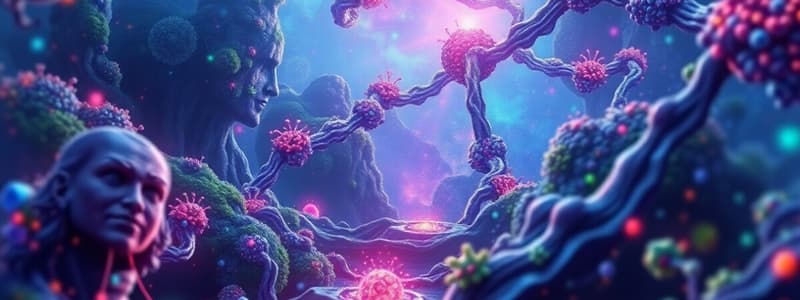Podcast
Questions and Answers
What is the role of the database schema?
What is the role of the database schema?
- It describes all entities, attributes, and relationships. (correct)
- It holds the physical records stored in the database.
- It provides a summary of the database applications.
- It manages user access to the database.
Which key is not part of the relational DBMS architecture?
Which key is not part of the relational DBMS architecture?
- Datatypes (correct)
- Relation
- Domain
- Attributes
What does the recovery system in a DBMS do?
What does the recovery system in a DBMS do?
- Restores the database to a previous consistent state. (correct)
- Enhances security against unauthorized access.
- Supports data manipulation through SQL.
- Maintains the structure of data in the database.
What is the primary function of a Data Definition Language (DDL) in the DBMS?
What is the primary function of a Data Definition Language (DDL) in the DBMS?
Which of the following options describes the external schema in a DBMS?
Which of the following options describes the external schema in a DBMS?
What is the primary function of biological databases in bioinformatics?
What is the primary function of biological databases in bioinformatics?
What distinguishes secondary databases from primary databases?
What distinguishes secondary databases from primary databases?
What is an example of a primary database?
What is an example of a primary database?
What role do composite databases play in bioinformatics?
What role do composite databases play in bioinformatics?
Which of the following statements is true regarding DNA databases?
Which of the following statements is true regarding DNA databases?
What type of data do archival databases primarily hold?
What type of data do archival databases primarily hold?
What is the main advantage of using tools associated with biological databases in bioinformatics?
What is the main advantage of using tools associated with biological databases in bioinformatics?
What type of databases are OWL, NRD, and Swissprot + TREMBL categorized as?
What type of databases are OWL, NRD, and Swissprot + TREMBL categorized as?
What is a primary limitation of traditional file-based systems regarding data access?
What is a primary limitation of traditional file-based systems regarding data access?
Which issue is associated with the atomicity of updates in file-based systems?
Which issue is associated with the atomicity of updates in file-based systems?
How does database management software (DBMS) benefit organizations?
How does database management software (DBMS) benefit organizations?
What does data isolation in traditional file-based systems refer to?
What does data isolation in traditional file-based systems refer to?
Which of the following describes a characteristic of a database?
Which of the following describes a characteristic of a database?
In terms of security issues, what problem do traditional file-based systems face?
In terms of security issues, what problem do traditional file-based systems face?
What is one of the prominent weaknesses of file-based systems associated with data redundancy?
What is one of the prominent weaknesses of file-based systems associated with data redundancy?
Which term refers to the complete definition or description of a database structure and constraints?
Which term refers to the complete definition or description of a database structure and constraints?
Flashcards
Biological Databases
Biological Databases
Databases storing and retrieving DNA sequencing information.
Primary Databases
Primary Databases
Archival databases storing original experimental results.
Secondary Databases
Secondary Databases
Databases that process primary data using algorithms.
Composite Databases
Composite Databases
Signup and view all the flashcards
GenBank
GenBank
Signup and view all the flashcards
DNA Alignment
DNA Alignment
Signup and view all the flashcards
Bioinformatics
Bioinformatics
Signup and view all the flashcards
Sequence Similarity Searches
Sequence Similarity Searches
Signup and view all the flashcards
Relational DBMS
Relational DBMS
Signup and view all the flashcards
Database Schema
Database Schema
Signup and view all the flashcards
Data Definition Language (DDL)
Data Definition Language (DDL)
Signup and view all the flashcards
Data Manipulation Language (DML)
Data Manipulation Language (DML)
Signup and view all the flashcards
Database Management System (DBMS)
Database Management System (DBMS)
Signup and view all the flashcards
Database
Database
Signup and view all the flashcards
DBMS
DBMS
Signup and view all the flashcards
Data Redundancy
Data Redundancy
Signup and view all the flashcards
Data Inconsistency
Data Inconsistency
Signup and view all the flashcards
Data Isolation
Data Isolation
Signup and view all the flashcards
Integrity Problem
Integrity Problem
Signup and view all the flashcards
Atomicity
Atomicity
Signup and view all the flashcards
Concurrent Access
Concurrent Access
Signup and view all the flashcards
Study Notes
Introduction to Biological Databases
- Bioinformatics is a field where biology, computer science, and information technology combine.
- Biologists collect molecular data (DNA, protein sequences, gene expression).
- Computer scientists (and related fields) develop tools, software, and algorithms for storing and analyzing data.
- Bioinformaticians use analyzed molecular data to study biological questions.
- Bioinformatics aims to understand living cells and their functions at a molecular level.
- Bioinformatics uses computers to store, retrieve, manipulate, and distribute information on biological macromolecules (RNA, DNA, and proteins).
- Computational biology encompasses all areas of biology that involve computation.
What is a Database?
- A database is a computerized archive used to organize and store data.
- Databases can be visualized as a stack of record cards.
- Each record card includes specific information fields like name, address, phone number, birth date.
- Each field within a record holds a value (can be null).
- Searching databases involves retrieving entries with specific values in a particular field.
- Biological databases often have more complex requirements than general-purpose databases.
DNA Database Overview
- Bioinformatics has two major components:
- Storing/retrieving information about DNA sequencing using biological databases.
- Manipulating the information with tools to explore various aspects (e.g., sequence similarity, protein function).
- Biological Databases serve as a storage place for DNA sequence information. Users query these databases for specific information.
Types of Biological Databases
- Databases are categorized as:
- Primary Databases: These hold experimental data on DNA sequences, and three-dimensional structures; Examples: GenBank, EMBL, DDBJ.
- Secondary Databases: These are analyses of primary database data; Examples: SWISS-PROT, TrEMBL, and UniProt.
- Composite Databases: These merge and filter data from primary sources to answer specific biological research questions; Examples: OWL, NRD, and Swiss-Prot.
- Some specialized databases focus on a particular organism (e.g. SGD for yeast).
Traditional File-Based Systems
- A file is a collection of logically related records.
- Each record contains one or more fields, representing characteristics of the modeled object.
Limitations of File-Based Approach
- Data redundancy and inconsistency (multiple files, duplicate data).
- Difficulty accessing data (need to write new programs for each task).
- Data isolation (multiple files and formats).
- Integrity problems (integrity constraints not explicitly addressed in program code).
- Atomicity problems (partial updates lead to inconsistent database states).
- Concurrent access issues (multiple users can cause inconsistencies).
- Security problems (limited ability to control data access).
What is Database?
- A database is a shared collection of logically related data, and a description of this data, designed to meet the information needs of an organization.
- A DBMS (Database Management System) is a software system that enables users to define, create, maintain, and access the database.
Database Management System (DBMS)
- DBMS enables users to define, update, manipulate, and retrieve data using Data Definition Language (DDL) and Data Manipulation Language (DML) like SQL.
- DBMS provides controlled access, security, integrity, concurrency control, recovery, and catalog.
Types of Databases
- Hierarchical databases
- Network databases
- Relational databases
- Object-oriented databases
Relational Database
- Relational DBMS (RDBMS) organizes data as tables with relationships described by three "keys": relation, domain, and attribute.
Database Schemas
- Database schema describes all the data entities, attributes, and relationships with integrity constraints.
- The database schema consists of different views (external schemas).
- The conceptual schema describes entities, attributes, and relationships together with integrity constraints.
- Internal schema is data on stored records, representation methods, data fields and indexes.
- Mappings translate information, ensuring data independence between different levels in the database (e.g. external to conceptual, conceptual to internal).
Studying That Suits You
Use AI to generate personalized quizzes and flashcards to suit your learning preferences.




